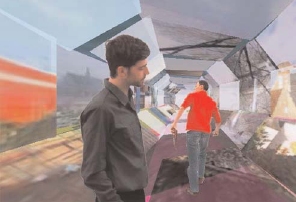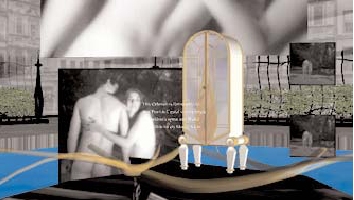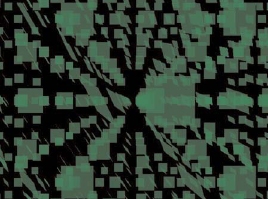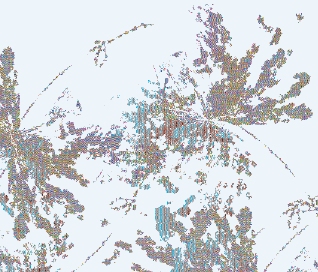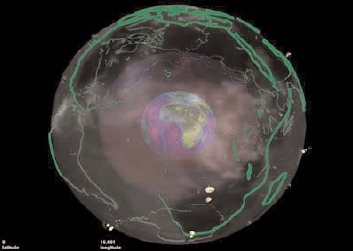The dimensional internet: Melinda Rackham
intelligent agent vol. 3 no. 2 -Web3D -empyre- lab3D, 2003
Inframonde – a participative landscape
Régis Albignac [landscape designer], François Lemarchand [php programmer], Grégoire Zabé [web3D artist]
“It’s the metaphysical space that offers the possibility of new perspective.” Canadian writer Jim Andrews opened the discussion with his observation that being able to see things from more than one perspective or from a point of view outside oneself was the attraction of 3D. This metaphysical space created in VRML artworks like my project Empyrean — a micro- and macro-, soft-bodied multi-user cosmos — is concerned with poetics and conceptual content rather than with imitation of real world spaces. Grégoire Zabé, an artist and designer who often works with telepresence thematics reminded us that we are all involved in the “art of illusion.” However, even though the technology that artists use to make 3D art worlds may be advancing quickly, issues of navigation, interaction, and presentation can still prove to be tricky. An issue encountered by many online viewers of 3D work was that of the accessibility of plug-ins and the challenge presented by the lack of standards in 3D online spaces. Currently UK-based Roya Jakoby finds “all these requirements for viewing very irritating and annoying. I personally prefer work that is accessible for the broader public and simple in its technical and ideological requirements. Where would all those 3D sculptures and landscapes take me if I could visit them all?” Crystal Cabinet, Steve Guynup
Keeping work conceptually complex but technically simple seemed to be a way to overcome imposed incompatibilities. Most artists aim for relatively low polygon counts to enable modem-using home audiences to experience 3D work with some fluidity. Others, like John Klima, whose networked software Earth — a geo-spatial visualization system — also has a Web-based component, has found that “native Java allows the widest possible compatibility and needs no plug-in whatsoever. In the end, compromising visual quality and performance for broad accessibility made the most sense for Web distribution.” Memory Forest from Memory Plains Returning
Adam Nash, 2003
Rise + Shine, Roya Jakoby
Commenting on the artist’s and the viewer’s influence on time, Grégoire Zabé argues that, in a certain way, both authors and spectators are “modelling” time, or sharing time in a relationship axis between creator and user that is unique to Web3D: “The dimension of a shared and delocalized space is an important part of Web3D for me. We can access and act on it at any time / everywhere we can find a computer and a connection. The spectator can perturb the space, make variances, and leave a trace of presence / absence in the work.” I proposed “that the relationship between 3D time and space, and components like sound and color have some fundamental overlaps, not existing in separate axes or dimensions but intertwining in the continuum of 3D space. Consequently, users are never free, they may have myriad choices but in computer-constructed space — in fact, in all space — all one can suggest is a finitude. Within the structure of the VRML language itself, there is a geographic limit, a time limit, a processor limit, a pitch limit. The author sets gravity, collision, sensors and triggers, anchors, horizons, and controls what the user sees at a time, so one sets the physics and also the emotions of the world.” But perhaps there is no need to define these relations so strongly. As Alan Sondheim philosophically muses (with regard to sound), “This would, of course, depend on the definition of ‘sound.’ There are arguments that tone or color, for example, depend on perception. Certainly, there are vibrations, but sound might be of another color.” Zabé, refreshed after a hike in Vosgian mountains in eastern France, raises another variable concept that may occur when one experiences Web3D, which is “to become captive (in French that word is a synonym of fascinated) of the strong ‘aura’ of screens.” I couldn’t help wondering, “just how do you define aura, the invisible thing outside the skin of a human or object? Is it a material property? Is it a vibrational effect? Or an electrical charge? Is it associated with commodity value, e.g. the aura of wealth? I believe electronic works have all of these. They do generate their own charge, rhythm, glow, hype, uniqueness, value. The users are also uniquely generating a vibration or rhythm within them. Every user’s keystroke or mouse rhythm is like a digital signature.” Simon Biggs, whose work Babel uses the Dewey Decimal System as a mapping and navigation technique for the Internet itself, reminds us that “aura is projected onto the object by the viewer, not the other way around; a bit like those early theories, which had light and vision emanating from the eye, contrasting with current theories, which have external light sources emanating light, which is then reflected off the object of vision to the eye.” Jakoby counters that a large part of museum and gallery culture is founded on the exhibition of objects that were taken away from the various imperial colonies, which originally had spiritual (cultural) meaning or aura attached to them. “It is an emotional, somewhat transcendent quality inherent in a being, an object, a piece of art (no matter what medium). Some people also refer to it as the energy (of something) or charisma.” Biggs retorts, “the aura is an article of faith, as these things often are. As Derrida points out, any text is only completely written when it has been read. Interpretation is half the writing process.” This prompted me to pose the question, “are 3D environments only alive when a user is in them? Do they have inherent qualities and fixed meanings, or are they like an elemental particle that can fit many different combinations? Do they become like a recessive gene when sitting on the server waiting for human presence to activate them? Is it the passivity of the space (or the potential of the void) waiting for (hu)man to give it life?”
Writer Sue Thomas suggests that other things besides humans can act within the 3D environment — “nonhuman things, data-things, manifestations” — and proposes that, if flesh objects have electromagnetic fields, then perhaps the virtual object’s ‘aura’ is the data ‘thing.’ Regina Célia Pinto adds poetically, “wouldn’t this be just the definition of virtuality, the power of becoming?” Sondheim disagrees, stating that 3D environments are not alive: “Human interaction does give them life for that matter, the way rollerblades ‘come to life’ when someone is out skating. It’s a matter of function and reception.” He sees no delineation between the body and technology — “We’re prosthetic from the origin itself. Culture and language are already prostheses.” 3D games and 3D art Earth, John Klima
Writer and Diablo mistress geniwate states that she likes games and likes art but “in different contexts and different moods. I reckon that the sorts of experiences we seek from games and art are rather different; I think it is slightly misleading to try to put the two on the same experiential continuum.” And in the same vein, artist and developer Lloyd Sharpe wonders, “why is there a need to look only to the ‘larger / wider / bigger’ audience when developing these works? Is it actually important to engage the same audience that is somehow engaged by the spectacle that is 3D kill fests? [or maybe just tetris?]” As Simon Biggs points out, “the values that underlie the whole [game industry] ensure that anything of value is crushed, and all you are left with is the pornographic exploitation of the ‘user’… and ‘user’ is a good word, as the makers of this stuff are no different from the drug dealers who are looking to develop new ‘user’ markets (in fact, I have a lot more time for drugs than for contemporary media culture). The main gland I am interested in is the brain… not the adrenal or testes.” Betts responds, “To me, the best art reflects the culture it exists within, not just the output of a brain. A brain doesn’t function like a suspended entity divorced from the body, it’s a reflexive system within the body. Art should be about more than just the life of the mind.” To which Nash replied, “I don’t think I’ve ever played a game that made me think. Art makes a person think.” Developer Jon Cates believes that being “enmeshed in digital cultures locates us in / on this terrain and among various aspects, such as game -> art -> video -> theory practices, commerces + histories. In terms of the expectations of the markets, we should not forget to call attention to the constraints of the local, regional, national + global art-markets and the ways in which these constraints function to determine the qualities of the work produced.” In other words, we are operating in a meta-narrative and can no longer completely disentangle art from games. more The 2D space available here unfortunately only permits a window into the vibrant and prolific -empyre- debates. Other threads not covered here include the dynamic exchange on Cartesian space and the nature of technologically produced dimensionality itself, which unfolded in response to Simon Biggs’ statement that he wished to “escape the cultural hegemony of Western notions of space… and move away from the Western dualism that conventional 3D visualization systems are founded on.” Another timely dialogue between Kathy Huffman, Patrick Keller, Patrick Lichty, Taylor Nuttall, Melentie Pandilovsky, and Brett Stalbaum was concerned with situating 3D art in the museum and gallery. The full texts of the forum, from which all quotes in this article are drawn, can be accessed online in the -empyre- archives for June 2003 and will be additionally archived for posterity in the Rose Goldsen Archive of New Media Art at Cornell University. For a more comprehensive and detailed version, a freeware Reader with texts form both the offline lab3d symposium and the online forum — co-edited by Taylor Nuttall and myself and co-produced by Cornerhouse and Folly — will be available later in 2003 for web download or from participating organizations. lab3d uniquely brought together the often virtual platform of multi-user 3D game environments and the social spaces of 3D worlds, with the majority of the works being simultaneously accessed both online and in the gallery space. Utilizing multiuser 3D artworks and multi-user communication channels opened up multi-dimensional real-time dialogues involving both a local and global audience. Together, the show, symposiums, online forum, and reader represent the work, issues, and debates of a strong, networked 3D community and extend the practice, presentation, and language of 3D art. References: -empyre- : lab3d: Web3D2003: lab3d Reader: Artists: Simon Biggs: Babel Steve Guynup: The Crystal Cabinet Roya Jakoby: Rise + Shine John Klima: Earth Feng Membo: Q4U Michael Pinsky: In Transit Adam Nash: Memory Plains Returning Melinda Rackham: Empyrean Anthony Rowe: altzero5 Tamiko Thiel: Beyond Manzanar Grégoire Zabé: Inframonde
Inframonde – a participative landscape
Régis Albignac [landscape designer], François Lemarchand [php programmer], Grégoire Zabé [web3D artist]
“It’s the metaphysical space that offers the possibility of new perspective.” Canadian writer Jim Andrews opened the discussion with his observation that being able to see things from more than one perspective or from a point of view outside oneself was the attraction of 3D. This metaphysical space created in VRML artworks like my project Empyrean — a micro- and macro-, soft-bodied multi-user cosmos — is concerned with poetics and conceptual content rather than with imitation of real world spaces. Grégoire Zabé, an artist and designer who often works with telepresence thematics reminded us that we are all involved in the “art of illusion.” However, even though the technology that artists use to make 3D art worlds may be advancing quickly, issues of navigation, interaction, and presentation can still prove to be tricky. An issue encountered by many online viewers of 3D work was that of the accessibility of plug-ins and the challenge presented by the lack of standards in 3D online spaces. Currently UK-based Roya Jakoby finds “all these requirements for viewing very irritating and annoying. I personally prefer work that is accessible for the broader public and simple in its technical and ideological requirements. Where would all those 3D sculptures and landscapes take me if I could visit them all?” Crystal Cabinet, Steve Guynup
Keeping work conceptually complex but technically simple seemed to be a way to overcome imposed incompatibilities. Most artists aim for relatively low polygon counts to enable modem-using home audiences to experience 3D work with some fluidity. Others, like John Klima, whose networked software Earth — a geo-spatial visualization system — also has a Web-based component, has found that “native Java allows the widest possible compatibility and needs no plug-in whatsoever. In the end, compromising visual quality and performance for broad accessibility made the most sense for Web distribution.” Memory Forest from Memory Plains Returning
Adam Nash, 2003
Rise + Shine, Roya Jakoby
Commenting on the artist’s and the viewer’s influence on time, Grégoire Zabé argues that, in a certain way, both authors and spectators are “modelling” time, or sharing time in a relationship axis between creator and user that is unique to Web3D: “The dimension of a shared and delocalized space is an important part of Web3D for me. We can access and act on it at any time / everywhere we can find a computer and a connection. The spectator can perturb the space, make variances, and leave a trace of presence / absence in the work.” I proposed “that the relationship between 3D time and space, and components like sound and color have some fundamental overlaps, not existing in separate axes or dimensions but intertwining in the continuum of 3D space. Consequently, users are never free, they may have myriad choices but in computer-constructed space — in fact, in all space — all one can suggest is a finitude. Within the structure of the VRML language itself, there is a geographic limit, a time limit, a processor limit, a pitch limit. The author sets gravity, collision, sensors and triggers, anchors, horizons, and controls what the user sees at a time, so one sets the physics and also the emotions of the world.” But perhaps there is no need to define these relations so strongly. As Alan Sondheim philosophically muses (with regard to sound), “This would, of course, depend on the definition of ‘sound.’ There are arguments that tone or color, for example, depend on perception. Certainly, there are vibrations, but sound might be of another color.” Zabé, refreshed after a hike in Vosgian mountains in eastern France, raises another variable concept that may occur when one experiences Web3D, which is “to become captive (in French that word is a synonym of fascinated) of the strong ‘aura’ of screens.” I couldn’t help wondering, “just how do you define aura, the invisible thing outside the skin of a human or object? Is it a material property? Is it a vibrational effect? Or an electrical charge? Is it associated with commodity value, e.g. the aura of wealth? I believe electronic works have all of these. They do generate their own charge, rhythm, glow, hype, uniqueness, value. The users are also uniquely generating a vibration or rhythm within them. Every user’s keystroke or mouse rhythm is like a digital signature.” Simon Biggs, whose work Babel uses the Dewey Decimal System as a mapping and navigation technique for the Internet itself, reminds us that “aura is projected onto the object by the viewer, not the other way around; a bit like those early theories, which had light and vision emanating from the eye, contrasting with current theories, which have external light sources emanating light, which is then reflected off the object of vision to the eye.” Jakoby counters that a large part of museum and gallery culture is founded on the exhibition of objects that were taken away from the various imperial colonies, which originally had spiritual (cultural) meaning or aura attached to them. “It is an emotional, somewhat transcendent quality inherent in a being, an object, a piece of art (no matter what medium). Some people also refer to it as the energy (of something) or charisma.” Biggs retorts, “the aura is an article of faith, as these things often are. As Derrida points out, any text is only completely written when it has been read. Interpretation is half the writing process.” This prompted me to pose the question, “are 3D environments only alive when a user is in them? Do they have inherent qualities and fixed meanings, or are they like an elemental particle that can fit many different combinations? Do they become like a recessive gene when sitting on the server waiting for human presence to activate them? Is it the passivity of the space (or the potential of the void) waiting for (hu)man to give it life?”
Writer Sue Thomas suggests that other things besides humans can act within the 3D environment — “nonhuman things, data-things, manifestations” — and proposes that, if flesh objects have electromagnetic fields, then perhaps the virtual object’s ‘aura’ is the data ‘thing.’ Regina Célia Pinto adds poetically, “wouldn’t this be just the definition of virtuality, the power of becoming?” Sondheim disagrees, stating that 3D environments are not alive: “Human interaction does give them life for that matter, the way rollerblades ‘come to life’ when someone is out skating. It’s a matter of function and reception.” He sees no delineation between the body and technology — “We’re prosthetic from the origin itself. Culture and language are already prostheses.” 3D games and 3D art Earth, John Klima
Writer and Diablo mistress geniwate states that she likes games and likes art but “in different contexts and different moods. I reckon that the sorts of experiences we seek from games and art are rather different; I think it is slightly misleading to try to put the two on the same experiential continuum.” And in the same vein, artist and developer Lloyd Sharpe wonders, “why is there a need to look only to the ‘larger / wider / bigger’ audience when developing these works? Is it actually important to engage the same audience that is somehow engaged by the spectacle that is 3D kill fests? [or maybe just tetris?]” As Simon Biggs points out, “the values that underlie the whole [game industry] ensure that anything of value is crushed, and all you are left with is the pornographic exploitation of the ‘user’… and ‘user’ is a good word, as the makers of this stuff are no different from the drug dealers who are looking to develop new ‘user’ markets (in fact, I have a lot more time for drugs than for contemporary media culture). The main gland I am interested in is the brain… not the adrenal or testes.” Betts responds, “To me, the best art reflects the culture it exists within, not just the output of a brain. A brain doesn’t function like a suspended entity divorced from the body, it’s a reflexive system within the body. Art should be about more than just the life of the mind.” To which Nash replied, “I don’t think I’ve ever played a game that made me think. Art makes a person think.” Developer Jon Cates believes that being “enmeshed in digital cultures locates us in / on this terrain and among various aspects, such as game -> art -> video -> theory practices, commerces + histories. In terms of the expectations of the markets, we should not forget to call attention to the constraints of the local, regional, national + global art-markets and the ways in which these constraints function to determine the qualities of the work produced.” In other words, we are operating in a meta-narrative and can no longer completely disentangle art from games. more The 2D space available here unfortunately only permits a window into the vibrant and prolific -empyre- debates. Other threads not covered here include the dynamic exchange on Cartesian space and the nature of technologically produced dimensionality itself, which unfolded in response to Simon Biggs’ statement that he wished to “escape the cultural hegemony of Western notions of space… and move away from the Western dualism that conventional 3D visualization systems are founded on.” Another timely dialogue between Kathy Huffman, Patrick Keller, Patrick Lichty, Taylor Nuttall, Melentie Pandilovsky, and Brett Stalbaum was concerned with situating 3D art in the museum and gallery. The full texts of the forum, from which all quotes in this article are drawn, can be accessed online in the -empyre- archives for June 2003 and will be additionally archived for posterity in the Rose Goldsen Archive of New Media Art at Cornell University. For a more comprehensive and detailed version, a freeware Reader with texts form both the offline lab3d symposium and the online forum — co-edited by Taylor Nuttall and myself and co-produced by Cornerhouse and Folly — will be available later in 2003 for web download or from participating organizations. lab3d uniquely brought together the often virtual platform of multi-user 3D game environments and the social spaces of 3D worlds, with the majority of the works being simultaneously accessed both online and in the gallery space. Utilizing multiuser 3D artworks and multi-user communication channels opened up multi-dimensional real-time dialogues involving both a local and global audience. Together, the show, symposiums, online forum, and reader represent the work, issues, and debates of a strong, networked 3D community and extend the practice, presentation, and language of 3D art. References: -empyre- : lab3d: Web3D2003: lab3d Reader: Artists: Simon Biggs: Babel Steve Guynup: The Crystal Cabinet Roya Jakoby: Rise + Shine John Klima: Earth Feng Membo: Q4U Michael Pinsky: In Transit Adam Nash: Memory Plains Returning Melinda Rackham: Empyrean Anthony Rowe: altzero5 Tamiko Thiel: Beyond Manzanar Grégoire Zabé: Inframonde |

